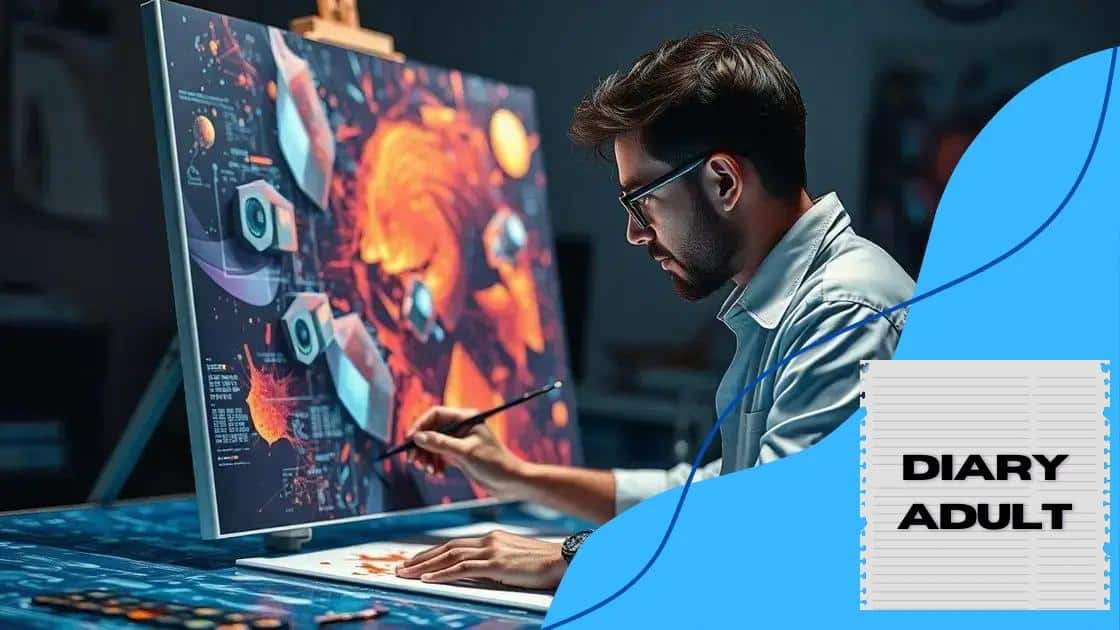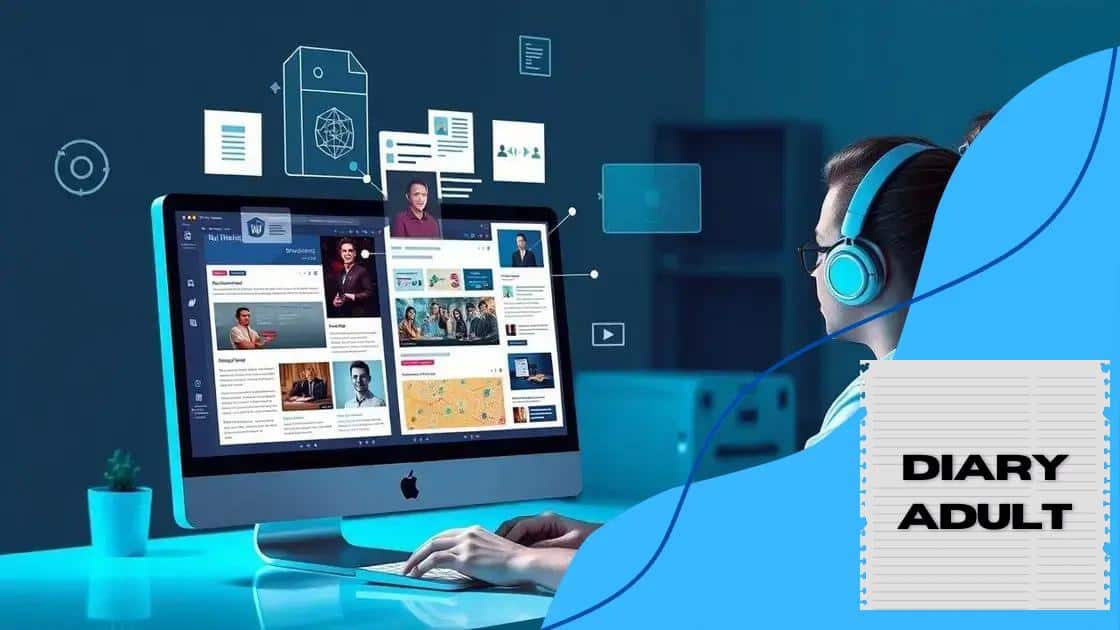The role of AI in transforming the creative industries

The role of AI in transforming the creative industries enhances creativity and efficiency, enabling artists and designers to produce innovative works while facing challenges like dependency and ethical concerns.
The role of AI in transforming the creative industries can be surprising. You might wonder how technology intersects with creativity. This article dives into those nuances.
How AI is changing creative thinking
The incorporation of AI in the creative process is fascinating. With its ability to analyze data and predict trends, AI is changing creative thinking significantly. Artists, writers, and designers are embracing tools that enhance their creativity and streamline their workflow.
New Opportunities for Inspiration
AI can generate ideas that a human might not consider. For example, it can analyze countless images or texts and create unique combinations. This capability not only inspires creators but also opens doors to new forms of art.
Collaborative Tools
Creative professionals are now using AI as a collaborator. AI tools can suggest edits, color palettes, or plot lines, helping individuals refine their ideas. This collaboration leads to innovative solutions and encourages a blend of human intuition and machine analysis.
- AI can generate mood boards based on themes.
- Writing assistants help structure stories or articles.
- Design software offers suggestions based on user input.
- Predictive text tools enhance the writing process.
Moreover, the impact of AI on creative thinking extends beyond just idea generation. It challenges traditional methods of creation. For instance, artists are experimenting with AI-generated art to explore the boundaries of creativity. This results in works that reflect a synthesis of human and machine creativity. Creators are now rethinking the concept of originality as AI-generated pieces gain recognition.
Adapting Creative Processes
The integration of AI into creative processes often requires adaptation. Artists and writers must learn how to leverage AI technology effectively. The change can be daunting, yet it creates a competitive edge. Those who adapt can produce work that is not only innovative but also resonates with modern audiences.
As AI continues to evolve, it influences the way creativity is perceived. No longer confined to traditional forms, creativity now embraces technology. AI challenges creators to push their boundaries, redefine their practices, and engage more deeply with their audiences. By doing so, they remain relevant in an ever-changing landscape.
AI tools for artists and designers
In the creative world, AI tools for artists and designers are rapidly evolving. These tools not only support the creative process but also inspire new methods of creation. As technology advances, artists and designers can harness AI to enhance their work in exciting ways.
Types of AI Tools
Various AI tools are available that cater specifically to different aspects of artistry and design. These tools range from image generation software to writing assistants, each providing unique functionalities that streamline the creative workflow.
- Image Generation Tools: Programs like DALL-E and Midjourney can create stunning visuals from text prompts.
- Design Software: Tools such as Canva utilize AI to suggest layouts and color schemes.
- Writing Assistants: AI like Grammarly and Jasper aids in fine-tuning content, helping writers express their ideas more clearly.
- Music Composition: Applications like AIVA can compose music tailored to specific moods or themes.
Moreover, these tools encourage collaboration between human creativity and machine efficiency. Artists can push their limits, exploring styles and techniques they may not have tried otherwise. AI helps minimize tedious tasks, giving creators more time to focus on the essence of their work.
The Benefits of AI Integration
The integration of AI into the creative process offers numerous benefits. For instance, AI can assist in analyzing market trends and audience preferences. This insight allows artists to tailor their work to meet current demands, ensuring relevance in a competitive industry. Designers benefit from having access to data-driven insights, which help shape their projects.
In addition, AI tools can foster a more playful and experimental mindset. Artists can quickly generate variations of their designs, enabling them to explore multiple directions before settling on the final piece. This flexibility can lead to unexpected breakthroughs and innovations in artistry.
As artists and designers embrace these technologies, they discover a new way of working that combines imagination with the power of AI. By leveraging the strengths of AI tools, creators are better equipped to navigate the challenges of the ever-evolving creative landscape.
The impact of AI on content creation

The rise of AI has dramatically influenced content creation. Many creators are leveraging AI to enhance their work, making the process more efficient and innovative. This integration is transforming how content is generated, distributed, and consumed.
Speed and Efficiency
One major impact of AI is the speed at which content can be produced. Tools like GPT-3 allow writers to quickly generate articles, scripts, and social media posts. This means that companies can keep up with the demands of fast-paced digital marketing and provide fresh content regularly.
Quality Enhancement
AI also improves the quality of content. With algorithms that can analyze audience preferences, creators can tailor their work to better meet the needs of their target audience. AI tools can assist in editing and refining drafts, ensuring the final product is polished.
- Grammar Checkers: Ensure content is free of spelling and grammatical errors.
- Style Guides: Offer recommendations to maintain consistency in tone and voice.
- SEO Optimization: Suggest keywords and structures that improve search visibility.
- Content Suggestions: Help writers brainstorm ideas based on trending topics.
Moreover, AI can analyze data to anticipate which types of content will resonate most with specific demographics. By understanding audience behavior, creators can produce more engaging material that fosters connection.
The Role of Personalization
Another crucial aspect is personalization. AI systems can tailor content to individual preferences, providing users with a unique experience. Streaming services like Netflix utilize AI to recommend shows based on viewing habits. Similarly, marketers use AI to craft personalized email campaigns that drive engagement.
This push towards personalization challenges creators to think differently about their target audience. By understanding the diverse interests of users, content creators can engage their audience more effectively, leading to higher satisfaction rates.
As AI continues to evolve, its impact on content creation will likely grow. The convergence of human creativity and machine efficiency opens up limitless possibilities for those willing to adapt and experiment with new tools.
Challenges faced by creatives with AI
The integration of AI into the creative process brings numerous advantages, but it also presents some significant challenges. Understanding these hurdles is essential for artists, designers, and writers striving to incorporate AI into their work.
Dependence on Technology
One major challenge creatives face is the potential dependence on AI technologies. While these tools can enhance creativity, relying too heavily on them may limit genuine artistic expression. Artists might find themselves following AI suggestions instead of trusting their instincts, leading to a loss of individuality in their work.
Understanding AI Systems
Another hurdle is mastering how AI systems operate. Many creatives may lack the technical skills needed to effectively utilize these tools. This gap can create frustration and discourage artists from fully embracing AI.
- Learning new software can be time-consuming.
- Understanding AI algorithms requires a strong foundation in data analysis.
- Creatives may feel overwhelmed by the rapid pace of AI advancements.
- Finding quality resources and training can be challenging.
Moreover, as AI continues to evolve, so do its capabilities. Creatives must consistently update their knowledge to stay relevant, which can feel daunting in an ever-changing landscape.
Ethical Considerations
Ethics also play a crucial role. As AI generates content, questions around originality arise. What constitutes an original idea versus AI-generated content? Creatives grapple with these concepts as they strive to maintain their artistic integrity.
They may fear losing credit for their work or that their unique style could be replicated by AI, leading to feelings of insecurity. Navigating these ethical concerns is essential as the boundaries of creativity and technology blur.
Overall, while AI presents exciting opportunities, it also poses significant challenges for creatives. By acknowledging these issues, artists can better prepare themselves to adapt and thrive in this new landscape.
Future trends in AI and the creative sector
The future of AI in the creative sector looks promising and full of potential. As technology advances, we can expect significant changes in how artists and designers approach their work. With AI becoming more integrated into various creative processes, new opportunities and trends are emerging.
Integration of AI in Everyday Tools
In the coming years, more creative software will incorporate AI features, making advanced tools accessible to everyone. This integration will allow artists and designers to easily use AI for tasks like image editing, content generation, and audience analysis.
- Smart Recommendations: AI will suggest color palettes, layouts, and design elements based on user preferences.
- Automated Editing: Programs will streamline editing processes by making intelligent suggestions.
- AI Collaboration: Artists will collaborate with AI to create unique works, blending creativity with technology.
These innovations will make creative processes more efficient, enabling creators to focus more on their ideas rather than tedious tasks.
Personalization and Audience Engagement
Another trend we will see is a rise in personalization through AI. AI will analyze audience data to help creators reach their target demographics effectively. By understanding what resonates with their audience, artists can tailor their work to meet specific tastes.
This focus on personalization could lead to more interactive and engaging content. For instance, AI will help create immersive experiences in art and storytelling, allowing users to choose their paths or engage with art in new ways.
Ethical and Creative Challenges
As AI technology evolves, ethical considerations will also come to the forefront. Creatives will need to navigate issues of originality and ownership in an AI-driven landscape. Questions like “Who owns AI-generated art?” will challenge traditional notions of authorship.
Furthermore, balancing technology with human creativity will be crucial. As AI becomes more prevalent, artists will strive to maintain their unique voice in a world where machines can generate art.
Overall, the future of AI in the creative sector is a dynamic mix of innovation and challenge. As artists embrace these changes, they will shape the relationship between creativity and technology in fascinating new ways.
FAQ – Frequently Asked Questions about AI in the Creative Industries
How is AI impacting creativity?
AI enhances creativity by providing tools that help artists and designers explore new ideas while increasing efficiency.
What are the main challenges faced by creatives when using AI?
The main challenges include dependency on technology, ethical concerns about originality, and the need for new technical skills.
Can AI tools personalize content for audiences?
Yes, AI can analyze audience behavior and tailor content to better meet their preferences.
What future trends can we expect in AI and the creative industry?
Future trends include more AI integration into creative processes, increased personalization, and evolving ethical considerations around ownership.





